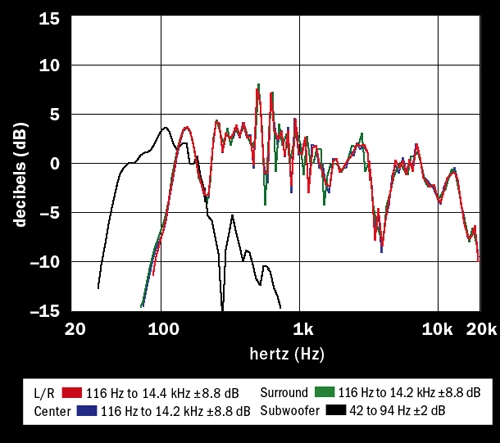Mirage MX 5.1 home theater speaker system Page 2

The MX satellite does indeed deliver Omnipolar power response, and its frequency response is virtually identical in all applications, with limited extension below 125 Hz, a 9-dB dip centered at 3.9 kHz, and an overall "peaky" character with narrow band ripples across its full bandwidth. Impedance falls to 2.8 ohms at 547 Hz, so the buyer needs to be certain that his receiver can handle this impedance. The subwoofer has fairly loud SPL capability at 62 Hz (for a tiny box), which falls by roughly 13 dB per octave below 62 Hz. Although unmarked, the sub has upper bandwidth extension to 207 Hz with the crossover control turned fully up. - Tom Nousaine
PERFORMANCE
Once I'd ironed out these setup issues, the Mirage system fell nicely into focus. It sounded pleasantly warm on typical pop/rock such as Little Feat's new Join the Band, and there was no sign of the overbearing lower-midrange thickness I'd heard initially. For example, on the classic "Dixie Chicken" (featuring Vince Gill and the incomparable slide guitarist Sonny Landreth as guest performers), Gill's characteristic, adenoidal new-country "honk" was subtly underlined by the Mirage's slight midrange emphasis, but there was little thud or overshoot from the middle-bass octaves. Highs were markedly relaxed, and while not overtly "airy," they had an effortless and spatially open quality that I ascribed to the MX's Omnipolar design.
For a miniaturized speaker system, the micro Mirages sounded surprisingly musical and dynamic when I listened to a Chesky SACD of early Baroque Viennese suites, producing a seamless bubble of believable acoustic space. Its tonal quality was natural and attractively unstrained, even on such prickly tests as harpsichord, organ, and recorders. And there was enough bass to plausibly suggest the scale of even bigger music, such as Mahler's Symphony No. 5 from an Angel DVD-Audio disc of Simon Rattle conducting the Berlin Philharmonic. In this case, the Mirage system fell short of achieving a realistic playback level, although it made a respectable attempt to reach that goal.
At this juncture, I decided that my 3,000-plus-cubic-foot studio was simply too much room for the tiny Mirage and relocated it to the family room, a much cozier space at 14 x 12 feet. Here the MX 5.1 seemed altogether more capable and louder, and while its ultimate bass output was still decidedly finite, it sounded more powerful and somehow deeper.
These results worked to surprising effect when watching movies. With the Air Force One DVD, the MX satellites formed a very solid screen-front, and their somewhat more diffuse character on sharply localized effects proved to be a plus in the smaller room, keeping wide sound-effects pans from "pulling" laterally. The center speaker did a competent job on dialogue (and, of course, given its design, showed no off-axis tonal shifting), but its highly dispersive nature inherently makes it a bit less clear and articulate than the best conventional center speakers I've heard.
I also discovered that placing the center-channel MX just in front of the glass below my TV's screen wasn't an ideal arrangement. I soon found that reflections from its generous upward and rearward coverage produced an audible comb-filtering tinge on some voices. Pulling the speaker out 18 inches in front of the screen largely eliminated this effect, but buyers should still keep it in mind when planning their installation.
Heavy surround effects including Air Force One's classic parachute-drop/refueling sequence were impressively immersive -- despite its limited bass, the MX makes for a very good surround speaker. And while the MM-6 couldn't deliver the full impact of big-budget bang-ups like the airborne tanker explosion, it suggested them a good deal better than I expected.
BOTTOM LINE
Look, $1,200 is a lot to pay for a truly tiny speaker system. And spending that money on more conventional but far larger and bulkier solutions -- including several from Mirage and its other Klipsch siblings -- will yield more bang for the bucks. But if you simply must have minuscule speakers, consider the MX 5.1. With Mirage's unique Omnipolar sound, it's truly a class apart from the all-in-one micros you'll find down at the shopping plaza.
- Log in or register to post comments




















































